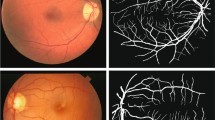Abstract
Segmented retinal blood vessels play a significant role in the clinical analysis of retinal vascular structure, which helps detect any eye diseases to prevent untimely impaired vision. With the rate of vision impairments globally, there is a need for a fast-automatic retinal blood vessel segmentation model to aid early detection of DR before its rapid progression to the high-risk stage of vision loss and blindness. The traditional UNET network has demonstrated steep success in biomedical segmentation tasks but is limited by the complexity of long training time due to many parameters. This paper proposes a hybrid encoder-decoder model based on the VGG16 encoder as the backbone and U-Net decoder with transfer learning for retina blood vessel segmentation to leverage the drawbacks. This approach aims to modify the traditional UNET architecture to optimize the training time and minimize computational cost and process complexities. The proposed framework resolves the limitation of long training and execution time compared with some U-Net based models, alleviates the complexity of high parameters, reduces computational resources and cost, minimizes loss, and alleviates overfitting. The evaluation of the proposed model on the DRIVE dataset obtains a promising result.
Access this chapter
Tax calculation will be finalised at checkout
Purchases are for personal use only
Similar content being viewed by others
References
Reichel, E., Salz, D.: Diabetic retinopathy screening. In: Singh, R.P. (ed.) Managing Diabetic Eye Disease in Clinical Practice, pp. 25–38. Springer, Cham (2015). https://doi.org/10.1007/978-3-319-08329-2_3
World Health Organization. World report on vision. Geneva, World Health Organization, Switzerland (2019). https://creativecommons.org/licenses/by-nc-sa/3.0/igo World Health Organisation (WHO)
Fricke, T.R., et al.: Global prevalence of presbyopia and vision impairment from uncorrected presbyopia: systematic review, meta-analysis, and modelling. Ophthalmology 125(10), 1492–1499 (2018)
Bourne, R.R., et al.: Magnitude, temporal trends, and projections of the global prevalence of blind- ness and distance and near vision impairment: a systematic review and meta-analysis. Lancet Glob. Health 5(9), e888–e897 (2017)
Klein, R., Klein, B.E., Moss, S.E.: How many steps of progression of diabetic retinopathy are meaningful: the Wisconsin epidemiologic study of diabetic retinopathy. Arch. Ophthalmol. 119(4), 547–553 (2001)
Long, J., Shelhamer, E., Darrell, T.: Fully convolutional networks for semantic segmentation. IEEE Conference on Computer Vision and Pattern Recognition (CVPR), Boston, MA, pp. 3431–3440 (2015)
Ronneberger, O., Fischer, P., Brox, T.: U-Net: convolutional networks for biomedical image segmentation. In: Navab, N., Hornegger, J., Wells, W.M., Frangi, A.F. (eds.) MICCAI 2015. LNCS, vol. 9351, pp. 234–241. Springer, Cham (2015). https://doi.org/10.1007/978-3-319-24574-4_28
Lin, Y., Zhang, H., Hu, G.: Automatic retinal vessel segmentation via deeply supervised and smoothly regularized network. IEEE Access 7, 57717–57724 (2018)
Sharma, M., Sau, P.C.: Blood vessel segmentation using SegNet. In: 2019 4th International Conference on Information Systems and Computer Networks (ISCON), pp. 620–624. IEEE, November 2019
Yang, D., Ren, M., Xu, B.: Retinal blood vessel segmentation with improved convolutional neural networks. J. Med. Imaging Health Inf. 9(6), 1112–1118 (2019)
Guo, S., Wang, K., Kang, H., Zhang, Y., Gao, Y., Li, T.: BTS-DSN: deeply supervised neural network with short connections for retinal vessel segmentation. Int. J. Med. Inf. 126, 105–113 (2019)
Liang, Z., Liu, H., Zhao, X., Yu, L.: Segmentation of retinal vessels based on DenseNet-Attention-Unet model network. In: Proceedings of the 2nd International Conference on Industrial Control Network And System Engineering Research, pp. 111–117, June 2020
Kromm, C., Rohr, K.: Inception capsule network for retinal blood vessel segmentation and centerline extraction. In: 2020 IEEE 17th International Symposium on Biomedical Imaging (ISBI), pp. 1223–1226. IEEE, April 2020
Shirvan, H.N., Moghadam, R.A. Madani, K.: Retinal vessel segmentation by inception-like convolutional neural networks. In: DeLTA, pp. 53–58 (2020)
Zhang, W., Li, L., Cheong, V., Fu, B., Aliasgari, M.: Deep encoder-decoder neural networks for retinal blood vessels dense prediction. Int. J. Comput. Intell. Syst. 14(1), 1078–1086 (2021)
Simonyan, K., Zisserman, A.: Very deep convolutional networks for large-scale image recognition. arXiv preprint arXiv:1409.1556 (2014)
DRIVE: Digital Retinal Images for Vessel Extraction (2004). https://www.isi.uu.nl/Research/Databases/DRIVE/
Yi-de, M., Qing, L., Zhi-Bai, Q.: Automated image segmentation using improved PCNN model based on cross-entropy. In: Proceedings of 2004 International Symposium on Intelligent Multimedia, Video and Speech Processing, pp. 743–746. IEEE (2004)
Da, K.: A method for stochastic optimization. arXiv preprint arXiv:1412.6980 (2014)
Balakrishna, C., Dadashzadeh, S., Soltaninejad, S.: Automatic detection of lumen and media in the IVUS images using U-Net with VGG16 Encoder. arXiv preprint arXiv:1806.07554
Pravitasari, A.A., et al.: UNet-VGG16 with transfer learning for MRI-based brain tumor segmentation. Telkomnika 18(3), 1310–1318 (2020)
Nair, V., Hinton, G.E.: Rectified linear units improve restricted Boltzmann machines. In: Proceedings of the 27th International Conference on Machine Learning (2010)
Author information
Authors and Affiliations
Editor information
Editors and Affiliations
Rights and permissions
Copyright information
© 2022 The Author(s), under exclusive license to Springer Nature Switzerland AG
About this paper
Cite this paper
Sule, O.O. (2022). Hybrid Encoder-Decoder Model for Retinal Blood Vessels Segmentation. In: Abraham, A., et al. Proceedings of the 13th International Conference on Soft Computing and Pattern Recognition (SoCPaR 2021). SoCPaR 2021. Lecture Notes in Networks and Systems, vol 417. Springer, Cham. https://doi.org/10.1007/978-3-030-96302-6_49
Download citation
DOI: https://doi.org/10.1007/978-3-030-96302-6_49
Published:
Publisher Name: Springer, Cham
Print ISBN: 978-3-030-96301-9
Online ISBN: 978-3-030-96302-6
eBook Packages: Intelligent Technologies and RoboticsIntelligent Technologies and Robotics (R0)




